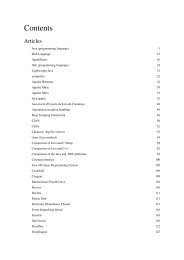Essentials of Javascript - Cultural View
Essentials of Javascript - Cultural View
Essentials of Javascript - Cultural View
Create successful ePaper yourself
Turn your PDF publications into a flip-book with our unique Google optimized e-Paper software.
DWR (Java) 82<br />
DWR (Java)<br />
Developer(s) David Marginian / Joe Walker / Dojo Foundation<br />
Stable release 2.0.6 / February 12, 2009<br />
Preview release 3.rc2 / February 12, 2008<br />
Development status Active<br />
Written in Java and JavaScript<br />
Operating system Cross-platform<br />
Size 1.08 MB (archived)<br />
Type Ajax technology<br />
License Apache 2.0 Licence<br />
Website http://directwebremoting.org/<br />
DWR, or Direct Web Remoting, is a Java open source library that helps developers write web sites that include<br />
Ajax technology. It allows code in a web browser to use Java functions running on a web server as if those functions<br />
were within the browser.<br />
It consists <strong>of</strong> two main parts:<br />
• Code to allow JavaScript to retrieve data from a servlet-based web server using Ajax principles.<br />
• A JavaScript library that makes it easier for the web site developer to dynamically update the web page with the<br />
retrieved data.<br />
DWR takes a novel approach to Ajax by dynamically generating JavaScript code based on Java classes. [1] Thus the<br />
web developer can use Java code from JavaScript as if it were local to the web browser; whereas in reality the Java<br />
code runs in the web server and has full access to web server resources. For security reasons the web developer must<br />
configure exactly which Java classes are safe to export (which is <strong>of</strong>ten called web.xml or dwr.xml).<br />
This method <strong>of</strong> remoting functions from Java to JavaScript gives DWR users a feel much like conventional RPC<br />
mechanisms like RMI or SOAP, with the benefit that it runs over the web without requiring web browser plug-ins.<br />
DWR does not consider the web browser / web server protocol to be important, and prefers to ensure that the<br />
programmer's interface is natural. The greatest challenge to this is to marry the asynchronous nature <strong>of</strong> Ajax with the<br />
synchronous nature <strong>of</strong> normal Java method calls.<br />
In the asynchronous model, result data is only available some time after the initial call is made. DWR solves this<br />
problem by allowing the web developer to specify a function to be called when the data is returned using an extra<br />
method parameter.This extra method is called CallBack Method.<br />
Here is a sample Callback:<br />
MJavaClassOnJs.getListProducts(selectedCategory,{<br />
callback:function(returnedList){<br />
dwr.util.addOptions(myComboId,returnedList,"productId","productName")<br />
}<br />
})<br />
The callback is that function inside the Json object passed as an additional parameter to the remoted function.<br />
With version 2.0 DWR supports Reverse Ajax [1] where Java code running on the server can deliberately send<br />
dedicated JavaScript to a browser.










